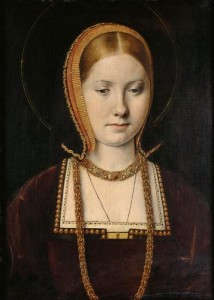 Something which came up on my Facebook feed this morning because it was shared on several Tudor history pages was the National Gallery of Art in Washington D.C. being criticised for their “major mistake”. The Queen Catherine Parr Facebook page shared a photo from the gallery’s Facebook page and stated that the “portrait of Catherine of Aragon is misidentified on the wall and in a new publication as Mary “Rose” Tudor, sister of King Henry VIII”.
Something which came up on my Facebook feed this morning because it was shared on several Tudor history pages was the National Gallery of Art in Washington D.C. being criticised for their “major mistake”. The Queen Catherine Parr Facebook page shared a photo from the gallery’s Facebook page and stated that the “portrait of Catherine of Aragon is misidentified on the wall and in a new publication as Mary “Rose” Tudor, sister of King Henry VIII”.
This post has been shared around and has provoked a lot of debate, which is always good, but it has also provoked some quite nasty comments aimed at the gallery, which is a shame as they were working on a re-identification done in 2008 by Paul G. Matthews, an art historian with expertise on the Hapsburgs and their portraiture. This re-identification is not new, Matthews’ work was published in 2008 and we even examined this here on the Anne Boleyn Files back in 2012 when Nasim Tadghighi wrote an article on it- Katherine of Aragon or Mary Tudor? – The Re-identification of Michel Sittow’s Portrait of a Young Woman – after her sister had visited the the Kunsthistorisches Museum in Vienna and seen this portrait labelled as “Mary ‘Rose’ Tudor”. Nasim contacted the museum and they sent her a copy of Matthews’ article to explain why the portrait had been re-identified.
I myself saw this portrait labelled as Mary Tudor when I visited “The Tudors” exhibition at the Musée du Luxembourg in Paris in 2015, which was in association with the National Portrait Gallery (NPG) of London which had held the same exhibition. So, Washington D.C.’s National Gallery of Art is not the only gallery to have displayed Sittow’s painting with this identification.
Whatever our views on this portrait, I don’t believe it is fair to say that the Washington gallery’s label is a “mistake” or error. We can disagree with it, but the gallery is simply going on a re-identification done by an expert that has also been accepted by other galleries and experts. Debate continues over this portrait and I’m sure will do for many years, and perhaps its identification will change again in the future. It is frustrating that we cannot prove conclusively, for the time being, who the sitter is, but we can enjoy debating it. I do hope more work will be done on this portrait.
Nasim’s article can be read at Katherine of Aragon or Mary Tudor? – The Re-identification of Michel Sittow’s Portrait of a Young Woman. The National Gallery of Art’s Facebook post regarding their exhibition “Michel Sittow: Estonian Painter at the Courts of Renaissance Europe”, which provoked this social media ‘debate’, can be found here